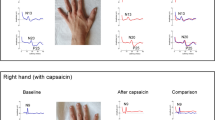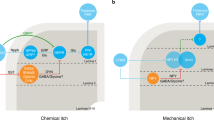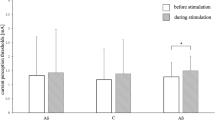Abstract
IT is common experience that inflamed tissues are hypersensitive to pain. Direct experiments have shown that this hypersensitivity may result from the increased sensitivity of the receptors in the injured tissues1. On the other hand, MacKenzie2, as far back as 1893, suggested that hypersensitivity could be the result of increased sensitivity of structures in the central nervous system. According to this investigator, sensory impulses arising in the injured tissues create an “irritable focus” in the segment of the spinal cord at which they enter. As a result a stimulus which would not evoke a sensation of pain in undamaged tissue begins to do so, if the afferent impulses set up by the stimulus reach the “irritable focus”. Participation of central mechanisms in the development of hyperaesthesia was then confirmed by a number of observations3–7. It has not yet been made clear, however, just where this “irritable focus” is created—that is, at which synaptic relay the facilitation elicited by impulses arising in the injured tissues occurs. A number of suggestions have been made previously5,8,9, but none is satisfactory.
This is a preview of subscription content, access via your institution
Access options
Subscribe to this journal
Receive 51 print issues and online access
$199.00 per year
only $3.90 per issue
Buy this article
- Purchase on Springer Link
- Instant access to full article PDF
Prices may be subject to local taxes which are calculated during checkout
Similar content being viewed by others
References
Echlin, F., and Propper, N., J. Physiol., 88, 388 (1937).
MacKenzie, J., Brain, 16, 321 (1893).
Chapman, L. F., Ramos, A. O., Goodell, H., and Wolff, H. G., Arch. Neurol., 4, 617 (1961).
Hardy, J. D., Goodell, H., and Wolff, H. G., Amer. J. Physiol., 133, 316 (1941).
Hardy, J. D., Wolff, H. G., and Goodell, H., J. Clin. Invest., 29, 155 (1950).
Hardy, J. D., Wolff, H. G., and Goodell, H., Pain Sensations and Reactions (Baltimore, Williams and Wilkins Company, 1952).
Sinclair, D. S., Weddell, G., and Feindel, W. H., Brain, 71, 184 (1948).
Alexander, F. A. D., and Lewis, L. W., in Anesthesiology, second ed., edit. by Hale, D. E., 801 (F. A. Davis Company, Philadelphia, 1963).
Ruch, T. C., in Medical Physiology and Biophysics, 350 (Saunders and Co.,Philadelphia and London, 1960).
Eccles, J. C., Eccles, R. M., and Lundberg, A., J. Physiol., 154, 89 (1960).
Author information
Authors and Affiliations
Rights and permissions
About this article
Cite this article
SMOLIN, L., SAMKO, N. Central Mechanism of Hyperaesthesia. Nature 211, 1412–1413 (1966). https://doi.org/10.1038/2111412a0
Issue Date:
DOI: https://doi.org/10.1038/2111412a0
This article is cited by
Comments
By submitting a comment you agree to abide by our Terms and Community Guidelines. If you find something abusive or that does not comply with our terms or guidelines please flag it as inappropriate.



